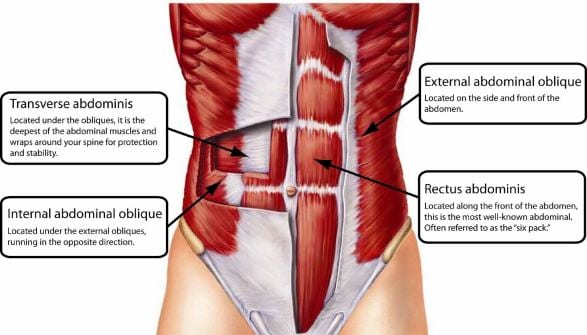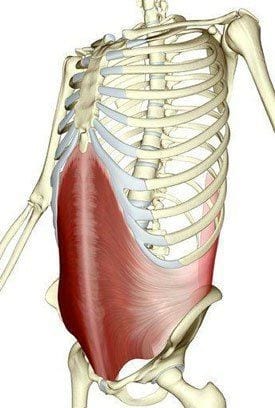Why do even fit people with a “six pack” of abdominal muscles develop low back pain associated with decreased inner core control?
Your core has multiple layers of muscles – the outermost muscles being the rectus abdominis (or the “six pack” muscle), external and internal obliques.

Your inner core stabilizing muscles are the transverse abdominis, multifidus, pelvic floor muscles, and your diaphragm. Transverse abdominis wraps around like a stabilizing corset, with muscle fibers going in a horizontal direction attaching to the thoracolumbar fascia, iliac crest (in your pelvis), lower ribs and inguinal ligament. See the illustrations below to visualize the muscle location.


Transverse Abdominis
These local stabilizing muscles’ main function is to maintain your posture against gravity throughout the day and they are designed to sustain a continuous activation and always be “on.” Other types of muscles like the rectus abdominis (“six pack”) and obliques are designed to be able to produce a muscle contraction with a notable change in muscle length in order to help you sit up or rotate your body when you needed. However, these muscles are designed to be “on” only when you are truly moving your body. For this reason, they are often called global movers. On the other hand, stabilizing muscles rarely get a break from gravity because we stand and sit the majority of the day and are responsible for initial control of every movement.
Think of the inner core stabilizers as a foundation for your house. If you build a shoddy foundation, the house will eventually break down due by instabilities. This sometimes happens with clients complaining of low back pain. Their stabilizers do not activate when they need to and they rely on more superficial muscles to brace themselves against gravity, which over time, creates an unnecessary amount of tension and pain in the body.
A common complaint from my clients with low back pain due to a decrease in inner core control, is pain during transitional movements, such as standing up after sitting, rolling over in bed, or holding prolonged static postures – standing, driving, or working by the computer. Some people have pain, or dysfunction, with higher level activities such as when trying to hold a plank or hit a tennis serve without hurting their back. In these scenarios, it’s possible the inner core does not know how to “kick in” at the right time and the back starts working over-time and compensating for a sleepy inner core.
If you feel your inner core muscles have been ignored, come see the Physical Therapists at CHARM. After an evaluation, we will teach you everyday strategies to use at home that allow you to stay in tune with your inner core. We will also use the Redcord NEURAC® method to help diagnose and treat your symptoms and isolate your inner core activation, without pain or compensatory movement patterns. Read more about the NEURAC method here. During your sessions, you will have an hour of one-on-one individualized treatment with a physical therapist who is an expert in utilizing the NEURAC to diagnose and treat your issues. Redcord NEURAC and the strategies we will teach you at CHARM can help alleviate the symptoms of pesky back pain, transform your daily life, or take your game to the next level. Today is a great day to stop ignoring your inner core.



